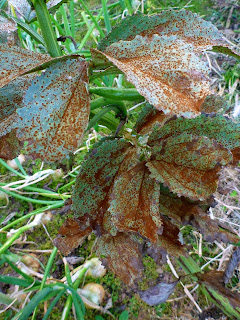Broad Bean Rust Spotted
Tonight, we noticed a bad case of broad bean rust on the allotment. (Click on photo to enlarge)
Broad bean rust (Uromyces viciae-fabae) is one of the most common fungal diseases of broad bean leaves from mid-summer. Like blight, it is spread by airborne spores and multiplies rapidly - quickly infecting the whole crop and spreading to other nearby crops.
Usually it develops too late to affect early-sown beans, although severe attacks like this one can cause all the leaves to drop. However, late-sown spring beans can suffer badly in July when the disease can also infect the pods, resulting in a reduction in yield.
If you have immature broad beans you should keep a very close eye on them. It is critical that you are able to identify the initial signs of rusting because it spreads very quickly.
Look out for the development of yellow spots on the underside of the leaves. Some spots may have a powdery outer surface that is easy to detect. You should continuously check for symptoms of rust and prune off and burn any infected foliage. Composting, or leaving infected vegetation on the ground will spread the disease.
Symptoms
Small, rusty-brown spots or pustules, often surrounded by a pale yellow halo on leaves and stems.
Control
Destroy infected plant material when you have finished picking your beans because spores can over-winter. Picking off and destroying infected foliage may help to slow the spread.
Broad bean rust (Uromyces viciae-fabae) is one of the most common fungal diseases of broad bean leaves from mid-summer. Like blight, it is spread by airborne spores and multiplies rapidly - quickly infecting the whole crop and spreading to other nearby crops.
Usually it develops too late to affect early-sown beans, although severe attacks like this one can cause all the leaves to drop. However, late-sown spring beans can suffer badly in July when the disease can also infect the pods, resulting in a reduction in yield.
If you have immature broad beans you should keep a very close eye on them. It is critical that you are able to identify the initial signs of rusting because it spreads very quickly.
Look out for the development of yellow spots on the underside of the leaves. Some spots may have a powdery outer surface that is easy to detect. You should continuously check for symptoms of rust and prune off and burn any infected foliage. Composting, or leaving infected vegetation on the ground will spread the disease.
Symptoms
Small, rusty-brown spots or pustules, often surrounded by a pale yellow halo on leaves and stems.
Control
Destroy infected plant material when you have finished picking your beans because spores can over-winter. Picking off and destroying infected foliage may help to slow the spread.
Submitted by Jane, plot 9

Comments
Post a Comment